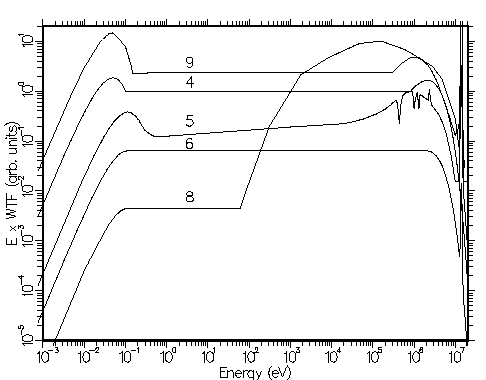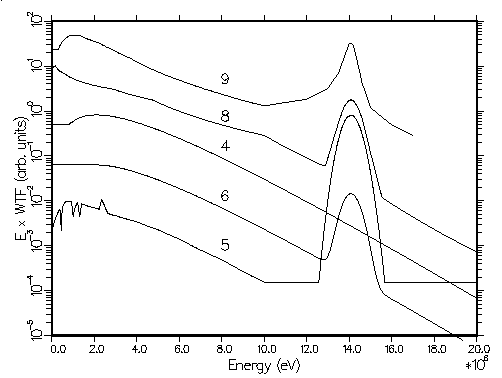As a first example, consider a typical water-moderated critical assembly, such as a power reactor. Neutrons are born at high energies (about 2 MeV) with a characteristic fission spectrum, many of them slow down by collisions with hydrogen nuclei in the water, resulting in a 1/E shape, and they finally come into equilibrium when they reach thermal energies, resulting in a Maxwellian shape appropriate to the temperature of the system. As shown in the following figure, GROUPR contains several builtin weighting functions that show this combination of shapes:

The curves are plotted as log-log "weight per unit lethargy" or E*W(E), which makes the central 1/E part of the curve flat. The parameters used to generate the curve for IWT=4 were a thermal temperature of .0253 eV joined to 1/E at 0.1 eV, and a fission temperature of 1.40 MeV joined to 1/E at 820.3 keV. Curve #8 is for a fast reactor or fusion blanket.
As a second example, consider a fusion system. The neutrons born in d-T reactions appear as a sharp peak centered near 14 MeV. They then scatter down to lower energies by elastic and inelastic processes, producing a shape in the 1 MeV range very similar to the fission spectrum. If there are few light isotopes around, few neutrons get to thermal energies, and a shape like #8 results. The high-energy shapes of some of GROUPR's built-in weighting functions are shown below:

Here is a brief summary of the built-in weighting functions:
- IWT=2, constant. Used for very fine group structures like the
640-group dosimetry structure.
- IWT=3, 1/E. Used for calculating resonance integrals.
- IWT=4, analytic thermal + 1/E + fission. Allows the
user to adjust the relative amounts of thermal and fission flux.
- IWT=5, mid-life PWR flux spectrum with a fusion peak added.
Includes some peaks and dips from oxygen, and some hardening of
the 1/E shape. Used for EPRI data and for the LANL
libraries using the WIMS structure.
- IWT=6, similar to 4, but the breakpoints were chosen to make
the curve continuous and a fusion peak was added.
- IWT=7, reserved.
- IWT=8, fast reactor weighting function. It has a fusion peak
and an intermediate shape typical of a fast reactor or fusion
blanket. A thermal part is provided at low energies for outer
regions of systems.
- IWT=9, CLAW weighting function. A typical thermal + 1/E
+ fission + fusion shape used for many years at Los Alamos.
- IWT=10, same at IWT=9, except the thermal part is automatically
recalculated to follow a Maxwellian law for the actual temperature.
- IWT=11, VITAMIN-E weighting function. Another thermal + 1/E
+ fission + fusion shape.